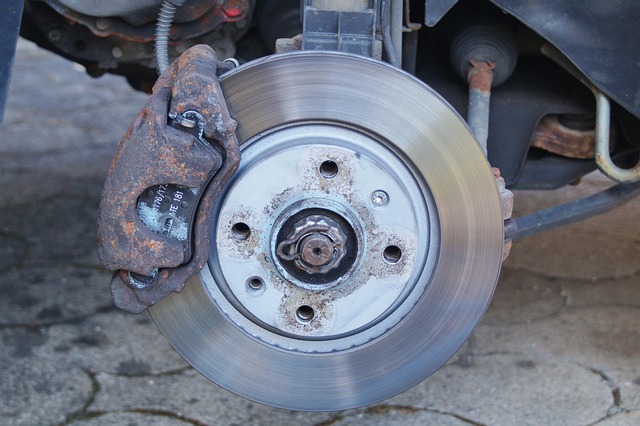Anti-lock Braking Systems (ABS) are vital for vehicle safety, preventing wheel lockup during hard braking through sensors, valves, and pumps. Regular servicing is crucial for commercial vehicles like semi-trucks, while custom upgrades enhance stopping power in sports cars. Select Brake Systems offers advanced diagnostics, using error codes and examining fluid condition to identify issues, including regenerative braking systems. Understanding repair techniques is vital; different vehicle models have distinct braking mechanisms requiring specific inspection and maintenance practices. Safety is paramount when repairing ABS systems; choosing OEM components from Select Brake Systems ensures compatibility and meets standards. Regular inspections catch early wear signs, and commercial vehicles consider use frequency and environmental factors for optimal brake pad durability.
“Experience seamless braking with expert ABS repairs. Understanding Anti-lock Braking Systems (ABS) is crucial for efficient and safe vehicle maintenance. This comprehensive guide delves into the intricate components and functionality of ABS systems, common malfunctions, and diagnostic methods. From repair techniques tailored to diverse brake system types to ensuring safety through best practices, this article offers invaluable insights for professionals and car enthusiasts alike. Discover the key to reliable select brake systems.”
- Understanding ABS Systems: Components & Functionality
- Common ABS Malfunctions and Diagnostic Methods
- Repair Techniques for Different Brake System Types
- Ensuring Safety: Best Practices for ABS Repairs
Understanding ABS Systems: Components & Functionality

Anti-lock Braking Systems (ABS) are a critical component in modern vehicles, designed to prevent wheels from locking up during hard braking events. Comprising various sensors, valves, and pumps, ABS works by rapidly detecting wheel speed variations and modulating brake pressure to maintain control. This advanced system ensures drivers retain steering ability, enhancing safety in emergency situations.
For commercial vehicles like semi-trucks, where brake maintenance is crucial for long-haul operations, understanding the ABS system goes beyond basic function. Regular checks and servicing, as outlined in a commercial vehicle brake servicing schedule, are vital to ensure peak performance. Moreover, custom brake upgrades tailored to specific sports car requirements can enhance stopping power while offering unique driving experiences—a stark contrast to the standard braking systems found in everyday vehicles.
Common ABS Malfunctions and Diagnostic Methods

ABS (Anti-lock Braking System) malfunctions can manifest in various ways, from unusual noises during braking to reduced brake performance or even complete failure to engage. Common issues include sensor problems, hydraulic leaks, and electrical failures. Diagnosing ABS problems requires a systematic approach using advanced tools for accurate readings.
Select Brake Systems offers comprehensive diagnostic services that begin with a thorough inspection of the entire brake system. This involves checking for worn or damaged components, including calipers, rotors, and wheel cylinders, as well as examining the condition of hydraulic fluid. Advanced diagnostic techniques, such as scanning for error codes from the ABS module, are employed to identify specific malfunction areas. In addition, understanding the integration of electric vehicle regenerative braking systems in modern vehicles is crucial, as these dynamic systems require meticulous care during repairs to ensure optimal safety and performance. The used brake parts marketplace also plays a role, with refurbished components adding affordability without compromising quality when properly inspected and vetted.
Repair Techniques for Different Brake System Types

When it comes to ABS repairs, understanding the specific techniques for different brake system types is paramount. Not all cars have identical braking mechanisms, and selecting the right repair method for each type is crucial. For instance, modern vehicles often feature electronic or hydraulic ABS systems, while older models might rely on mechanical designs. Each of these systems demands a unique approach during troubleshooting and fixing.
The process involves a meticulous brake system inspection to identify issues like worn-out pads, compromised rotors, or faulty sensors. A correct diagnosis is key before procuring the right car brake replacement parts online. Moreover, addressing unusual brake system noise can prevent further damage and ensure safe driving. Regular maintenance and timely repairs, especially after noticing symptoms like pulsating brakes or increased braking distance, are essential to extend the life of your vehicle’s braking components and keep costs down compared to a complete brake system overhaul.
Ensuring Safety: Best Practices for ABS Repairs

When it comes to ABS repairs, safety should always be the top priority. This intricate system is responsible for enhancing braking performance and preventing wheel lockup during emergency stops, making its proper functioning crucial for driver and passenger protection. Therefore, any repair work must adhere to best practices to ensure reliable and safe operation.
Choosing the right Select Brake Systems components is essential. Original Equipment Manufacturer (OEM) parts guarantee compatibility and performance that meet or exceed industry standards. Regular inspection of brake pads, rotors, and calipers for signs of wear, such as using a break pad wear indicator installation, is vital to catch potential issues early on. For commercial vehicle brake servicing, it’s also important to consider the frequency of use and environmental factors that can accelerate break pad wear. Lastly, while rear brake rotor replacement cost may vary depending on the make and model, ensuring that each component is in optimal condition will contribute to overall safety and system efficiency.
In conclusion, expert ABS repairs require a deep understanding of these critical systems that enhance vehicle safety. By mastering the functionality of ABS components, diagnosing common malfunctions, and adhering to best practices, technicians can ensure the reliability and safety of modern brake systems. When selecting brake systems for repair, it’s essential to consider the unique characteristics of each type, allowing for precise and effective solutions. This comprehensive approach to ABS repairs not only guarantees optimal performance but also safeguards drivers on the road.
